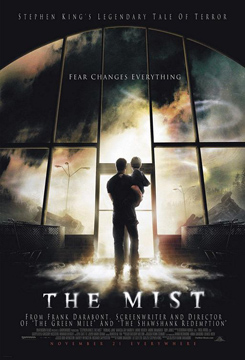 Frank Darabont’s The Mist
Frank Darabont’s The Mist
is far from a flawless work: its first act relies on contrived conflict
to set its ideologically (and theologically) diverse characters against
each other; the basic conventions of the narrative will be overly
familiar to anyone who’s seen "The Monsters are Due on Maple Street";
and, on a strictly superficial level, the sub-$20 million budget is
hell on the special effects. Of these shortcomings, it’s the latter
that will most heavily tax the viewer’s suspension of disbelief. And
it’s not really their fault; mainstream audiences should hardly be
expected to excuse a film’s budget when they’re passing over $10-plus
per ticket.
This is a highly precarious concession, but one that
was evidently required to bring the Stephen King novella – first
published in the 1980 horror omnibus Dark Forces, and, subsequently, in 1985’s Skeleton Crew
– to the big screen. It’s important to keep this in mind as Darabont’s
film introduces its stock dramatis personae and gets them talking past
each other as the mist rolls in over a small town supermarket bustling
with activity in the aftermath of a massive thunderstorm. And it’s
especially important to keep those allowances coming during the film’s
first creature attack, in which a completely unconvincing CG tentacle
wreaks havoc in the store’s stockroom. In fact, one might as well just
diminish their expectations for everything prior to the arrival of the
winged bugs ballyhooed by the film’s aggressive ad campaign (which
must’ve cost as much as the movie itself). Because that’s when The Mist starts paying off.
In a way, The Mist‘s
uncertain first act works to its advantage; those unacquainted with the
story will let their guard down, figuring that Darabont is up to
nothing more than a junky creature feature larded with classic Twilight Zone/Playhouse 90 pretensions. But attentive viewers might sense that the sentimentalist of The Shawshank Redemption and The Green Mile is up to something a little nastier than usual when Darabont’s camera lingers longer than necessary on a recreated poster of John Carpenter’s The Thing.
It’s supposed to be the work of David Drayton (Thomas Jane), a
beleaguered movie poster artist whose latest assignment is wiped out
when the aforementioned storm blows a branch through his workshop
window. And Darabont further invites comparisons to Carpenter’s classic
by introducing David’s long-standing conflict with his African-American
neighbor, Brent Norton (Andre Braugher).
But the storm seems
to have engendered a détente between the two men: i.e. since Brent’s
luxury auto was crushed in the storm, David offers to drive his
erstwhile rival into town. This is misdirection, of course, but
Darabont plays the scène à faire
as more than a cold function of the plot; as David and Brent warily
exchange small talk (with David’s young son, Billy, serving as a
civility buffer), it’s clear that contentiousness is only one
ill-considered utterance away. This isn’t rapprochement; it’s just a
practical, temporary cease fire.
Once the men arrive at the
supermarket, the rest of the world floods in, and it’s a whole lotta
microcosm. Though all small towns are uneasy jumbles of class and
intellect, Darabont exacerbates the disparities to ensure maximum
hysteria and hatred the instant the mist enshrouds the store. It’s a
bit much, and, in the case of Brent, who shoots from reasonable to
obstinate when David asks him to take the tentacle attack on faith,
it’s also too convenient – even as it’s gradually revealed that Brent
is a widely respected legal mind bucking for a seat on the Supreme
Court of the United States. With panic spreading throughout the
supermarket, Brent, unwilling to believe that there’s anything out in
the mist, mobilizes the people of color to follow him out into the
murky unknown to prove his hypothesis. It’s not an implausible
scenario, but it all goes down so quickly that it feels like a plot
device.
And it is. But it has to happen this way for Darabont to adequately set up the devastating third act reveals that elevate The Mist
from simple, second-rate Rod Serling-esque parable to potential horror
classic. As soon as Brent and his group exit, Darabont begins brewing
the discontent, which ultimately pits pragmatists versus zealots. The
primary catalyst for this conflict is Mrs. Carmody (Marcia Gay Harden),
an evangelical, fire-and-brimstone Christian who goes from nut to
prophet as the situation grows more desperate. For a while, the more
practical contingent, let by David, begrudgingly coexists with Carmody
and her converts as they plot their own exit strategy; but when she
begins calling for human sacrifice, the grim uncertainty of the mist
starts looking pretty darn inviting.
But how much grimness can
one take? That’s the final question put before David and his
survival-minded group – and it probably isn’t too much of a spoiler to
reveal that the final scene does not take place on a beach in Mexico.
Still, no one familiar with Darabont’s previous work could ever expect
him to deposit his characters in such a maelstrom of despair. The Mist
is an furious movie. Like many films released this fall, it’s brazenly
misanthropic and openly contemptuous of the country’s post-9/11
mindset. But before it arrives at its ghastly terminus, it’s a
thrilling horror film with a corroded conscience: women, children and
the elderly are all game for the dispatchin’. It’s been a while since
horror fans have been treated to a film this thoughtful and expertly
performed (by the entire company, which includes the masterful likes of
Toby Jones, Francis Sternhagen, William Sadler and a particularly
exceptional Jeffrey DeMunn).
It’s just that it’ll be a very long while before you want to watch it again. The Mist provides plenty of punishment to live on.